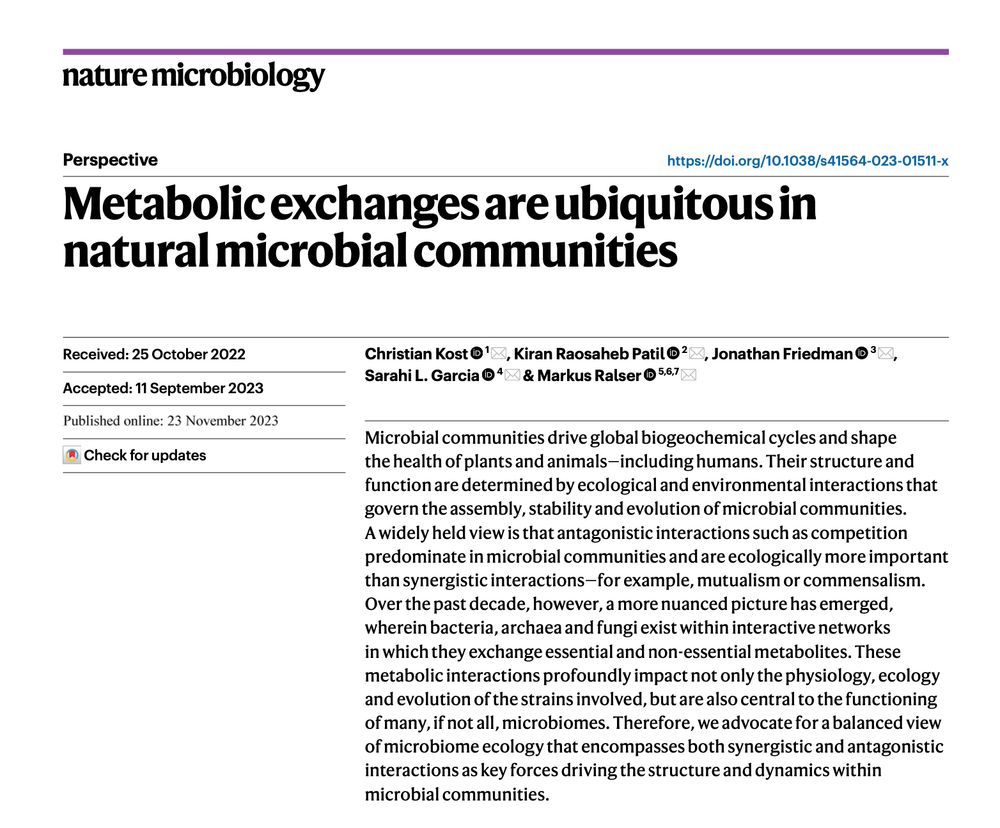Thanks, Ruairi!
21.11.2024 05:06 — 👍 0 🔁 0 💬 0 📌 0
Would be great to be added, thanks
20.11.2024 20:13 — 👍 1 🔁 0 💬 1 📌 0
@gregmedlock.bsky.social and me for the drug development side
20.11.2024 06:34 — 👍 1 🔁 0 💬 1 📌 0
I’m creating a drug development starter pack, reach out to join or suggest additions: go.bsky.app/B2pzQm2
10.11.2024 18:50 — 👍 49 🔁 26 💬 21 📌 7
I also enjoyed the positive reaction in the room at #cshlmbiome to our "succinotypes", recently published in BMC Microbiome from the pharmabiome.com team (doi.org/10.1186/s401...). The bimodal partitioning of the succinate consumer guild never ceases to amaze me. Summary: bsky.app/profile/gabe...
05.11.2024 08:20 — 👍 15 🔁 8 💬 0 📌 0

What pleasure to participate at #cshlmbiome last week! The science was really excellent—deep thinkers that are going after mechanisms in microbiomes and not just descriptive associations. It's what we need to move the translational field forward.
05.11.2024 08:04 — 👍 6 🔁 1 💬 0 📌 0

Researcher in mathematical modeling and simulation of ecological processes in the gut microbiota
Great opportunity to go work with Markus Arnoldini in the @mucosalimmunology.bsky.social group on a compuational project for gut bacterial population dynamics.
jobs.ethz.ch/job/view/JOP...
18.12.2023 11:05 — 👍 3 🔁 5 💬 0 📌 0

Metabolic exchanges are ubiquitous in natural microbial communities
Nature Microbiology perspective by @kostchristian.bsky.social et al @sarilog.bsky.social
www.nature.com/articles/s41...
24.11.2023 07:52 — 👍 46 🔁 30 💬 1 📌 2
Totally 🙃 thanks for commenting!
25.11.2023 12:59 — 👍 1 🔁 0 💬 0 📌 0
Interesting… so that would be acting in the opposite direction (with respect to succinate concentrations) to e.g. doi.org/10.1016/j.celrep.2021.109521
25.11.2023 12:50 — 👍 0 🔁 0 💬 1 📌 0
Hmmm… We show that both Phascolarctobacterium and Dialister consume succinate, but that (1) Dialister is slower and that (2) IBD patients are more likely to have Dialister compared to Phasco. How do you think that might influence mucosal healing?
25.11.2023 12:19 — 👍 0 🔁 0 💬 1 📌 0
Thanks, Karna!
24.11.2023 16:14 — 👍 0 🔁 0 💬 0 📌 0
In summary: Succinotypes stratify human gut microbiomes based on rate of succinate consumption, setting a mechanistic basis for a functional microbiome biomarker and therapeutic target. pharmabiome.com doi.org/10.1101/2023...
24.11.2023 15:32 — 👍 0 🔁 0 💬 0 📌 0

Indeed, we looked at the association of succinotypes with different diseases and found that IBD patients are significantly more likely to have a D-succinotype compared to a P-type.
24.11.2023 15:31 — 👍 0 🔁 0 💬 1 📌 0
Finally, because succinate accumulation is implicated in disease—in particular IBD (e.g. doi.org/10.1007/s111... ) we hypothesized that this difference in consumption rate might provide a mechanistic link between microbiome function and disease pathophysiology.
24.11.2023 15:31 — 👍 0 🔁 0 💬 1 📌 0

Going back to the consumption rate differences, we expected D succinotype microbiomes to consume succinate more slowly than P succinotypes, and amazingly D-types had higher fecal succinate concentrations than P-types!
24.11.2023 15:30 — 👍 0 🔁 0 💬 1 📌 0
Because of this mutual exclusivity, we decided classify human gut microbiomes into either D- or P-succinotypes, which to our understanding is a rare example of a classification based on function rather than just statistical patterns.
24.11.2023 15:30 — 👍 0 🔁 0 💬 1 📌 0

If this grouping were relevant, we expected Phascolarctobacterium and Dialister to be anticorrelated across human gut microbiomes. This turned out to be clearly the case, with the two genera mutually exclusive in the vast majority of any fecal samples we could get our hands on.
24.11.2023 15:30 — 👍 0 🔁 0 💬 1 📌 0
We thus supposed that Phascolarctobacterium and Dialister would be the relevant succinate consumers in actual gut environments (where alternative nutrient sources should be plentiful), forming a two-taxon functional group.
24.11.2023 15:29 — 👍 0 🔁 0 💬 1 📌 0

Interestingly, while Phascolarctobacterium and Dialister directly consumed the supplied succinate, Flavonifractor had diauxic consumption, suggesting it had a preference for any other nutrients in the base medium over succinate.
24.11.2023 15:29 — 👍 0 🔁 0 💬 1 📌 0
We thus hypothesized that these three bacteria are the relevant succinate consumers, and that differences in their individual consumption rates resulted in differences in the whole-community consumption rates, which turned out to be the case!
24.11.2023 15:29 — 👍 0 🔁 0 💬 1 📌 0

We discovered these using our NicheMap approach doi.org/10.1101/2023..., where we observed that fecal microbiomes differ in terms of the rate at which they consumed succinate, and this rate correlated with three different bacterial genera: Phascolarctobacterium, Dialister, and Flavonifractor.
24.11.2023 15:29 — 👍 0 🔁 0 💬 1 📌 0

Stratification of human gut microbiomes by succinotype is associated with inflammatory bowel disease...
bioRxiv - the preprint server for biology, operated by Cold Spring Harbor Laboratory, a research and educational institution
I'm excited to share the most recent work from the pharmabiome.com team, introducing the notion of 'succinotypes' in human gut microbiota. These correspond to the identity of the bacterial taxon that occupies the succinate consumption niche.
24.11.2023 15:28 — 👍 12 🔁 4 💬 3 📌 1
So sock-dogs per second? Sounds like a measure of knitting speed. Totally understandable, very easy to confuse knitting with space travel.
23.09.2023 18:18 — 👍 1 🔁 0 💬 1 📌 0
Assistant Professor @ UC Santa Barbara
Marine microbes, multicellularity, metagenomics
A Simons collaboration which investigates the principles underpinning the self-organization, structure, and function of #microbial communities in the #ocean.
Bundesamt für Gesundheit BAG
Office fédéral de la santé publique OFSP
Ufficio federale della sanità pubblica UFSP
https://www.bag.admin.ch/
Associate Professor of Biomedical Engineering
Duke University
Research in Evolutionary biology | Community ecology and evolution | she/her
also @marievasse@ecoevo.social
We publish #gastroenterology & #hepatology Reviews and opinion https://www.nature.com/nrgastro/
#GastroEdPick selections by the Editors: Katrina (@heykatray.bsky.social), Jordan & Eleni
#Gastrosky #LiverSky #Microsky #Medsky
A leading life science journal that champions high-impact research across all disciplines—from molecules to ecosystems. We offer innovative formats and collaborative editorial support to ensure your work achieves its full scientific impact.
Postdoc @ Duchossois Family Institute @ UChicago Pamer Lab. PhD Alumni @ IGCiencia #gut #microbiome #consortia #diet #machinelearning #Klebsiella
Assist. Prof., Clinician-Scientist,Dalhousie Dent. www.mhdlab.org Host-pathogen interactions enthusiast. Figuring out how our bodies talk to bugs (spoiler: they do!!), one molecule at a time. #newPI #womeninSTEM #microbiology #Immunology #Dentistry
Cofounder and COO at Concerto Biosciences where we aim to redefine humanity’s relationship with microbes.
Microbial engineering, biotech entrepreneurship, and LBP drug development.
Ni de aquí ni de aya 🇺🇸🇲🇽 | Views my own.
#Host-microbe #microbe-microbe interactions | Female reproductive tract #microbiome | #Phage biology | #Postdoc @Boston Children’s Hospital + @Harvard Medical School at www.srnlab.com
Alum @Max Planck Institute for Evolutionary Biology
#Epidemiologist · #MultiOmics · #MNCH · #Microbiota · #EED · #HumanMilk · #UGent · #AFRICSanté · #BrusselsGriffons
Human gut microbiome researcher
Postdoc at KU Leuven / VIB (BE)
Previously UMCG (NL)
Toxicokinetics and Nutrition Toxicology group leader at ETH Zürich. Developing microbiome-competent pharmacokinetic models for personalized and population-specific bioactivity/toxicity assessment.
PhD Student @ Penninger Lab 🧪
Hi everyone! I am a PhD candidate from the North of Spain. Currently focusing on study of microbiome and its relationship with colorectal cancer. I am developing bioinformatics pipelines and ML models to predict the outcome of treatments in CRC patients. 🤗
Bioinformatics and (eco-)Systems Biology | VIB-KU Leuven Center for Microbiology. @VIB @KU Leuven
https://raeslab.sites.vib.be/en
Lab led by Dr. Ruairi Robertson focussed on studying human microbiomes in pregnancy and infancy and their influence on child growth and infection









